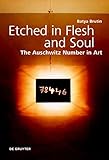Etched in Flesh and Soul : The Auschwitz Number in Art / Batya Brutin.
Material type: TextPublisher: Berlin ; Boston : De Gruyter, [2021]Copyright date: ©2022Description: 1 online resource (XVI, 203 p.)Content type:
TextPublisher: Berlin ; Boston : De Gruyter, [2021]Copyright date: ©2022Description: 1 online resource (XVI, 203 p.)Content type: - 9783110739916
- 9783110739961
- Gefangener
- Holocaust denial
- Holocaust, Jewish (1939-1945), and art
- Holocaust, Jewish (1939-1945), in art
- Holocaust
- Konzentrationslager Auschwitz
- Kunst
- Kunstgeschichte
- Nazi concentration camp tattoos -- Influence
- Nazi concentration camp tattoos
- Tattooing in art
- Tätowierung
- World War, 1939-1945 -- Prisoners and prisons, German
- Holocaust
- Kunst
- arts, Holocaust memory
- online - DeGruyter
- Issued also in print.
| Item type | Current library | Call number | URL | Status | Notes | Barcode | |
|---|---|---|---|---|---|---|---|
 eBook
eBook
|
Biblioteca "Angelicum" Pont. Univ. S.Tommaso d'Aquino Nuvola online | online - DeGruyter (Browse shelf(Opens below)) | Online access | Not for loan (Accesso limitato) | Accesso per gli utenti autorizzati / Access for authorized users | (dgr)9783110739961 |
Frontmatter -- Contents -- Preface -- List of Illustrations -- Introduction -- Chapter One: An Everlasting Scar — Auschwitz Tattooed Number -- Chapter Two: Life in the Shadow of the Auschwitz Number -- Chapter Three: The Auschwitz Number in Public and Private Commemoration -- Chapter Four: The Auschwitz Number as Holocaust Icon -- Epilogue -- Bibliography -- Index
restricted access online access with authorization star
http://purl.org/coar/access_right/c_16ec
A series of numbers was tattooed on prisoners’ forearms only at one location - the Auschwitz concentration camp complex. Children, parents, grandparents, mostly Jews but also a significant number of non-Jews scarred for life. Indelibly etched with a number into their flesh and souls, constantly reminding them of the horrors of the Holocaust. References to the Auschwitz number appear in artworks from the Holocaust period and onwards, by survivors and non-survivor artists, and Jewish and non-Jewish artists. These artists refer to the number from Auschwitz to portray the Holocaust and its meaning. This book analyzes the place that the image of the Auschwitz number occupies in the artist’s consciousness and how it is grasped in the collective perception of different societies. It discusses how the Auschwitz number is used in public and private Holocaust commemoration. Additionally, the book describes the use of the Auschwitz number as a Holocaust icon to protest, warn, and fight against Holocaust denial.
Eine Generation – Juden und Nicht-Juden gleichermaßen - für das Leben gezeichnet: eine Zahl, die im Konzentrationslager Auschwitz unauslöschlich in Fleisch und Seele eingraviert wurde, eine ständige Erinnerung an die Schrecken des Holocaust. Seit der Zeit der Shoah finden sich Bezüge zur Auschwitz-Nummer in vielen Kunstwerken - von Überlebenden und Nachgeborenen, von jüdischen und nicht-jüdischen Künstler/-innen. Der vorliegende Band analysiert den Stellenwert dieses Motivs im Bewusstsein der Künstler/-innen sowie im kollektiven Bewusstsein. Das Buch kompensiert den Mangel an umfassender Forschungsarbeit zu visuellen Darstellungen der Auschwitz-Nummer in der Kunst und untersucht die Art und Weise, wie Künstler/-innen dieses Motiv für die Auseinandersetzung mit zeitgenössischen Themen nutzen.
Issued also in print.
Mode of access: Internet via World Wide Web.
In English.
Description based on online resource; title from PDF title page (publisher's Web site, viewed 01. Dez 2022)


